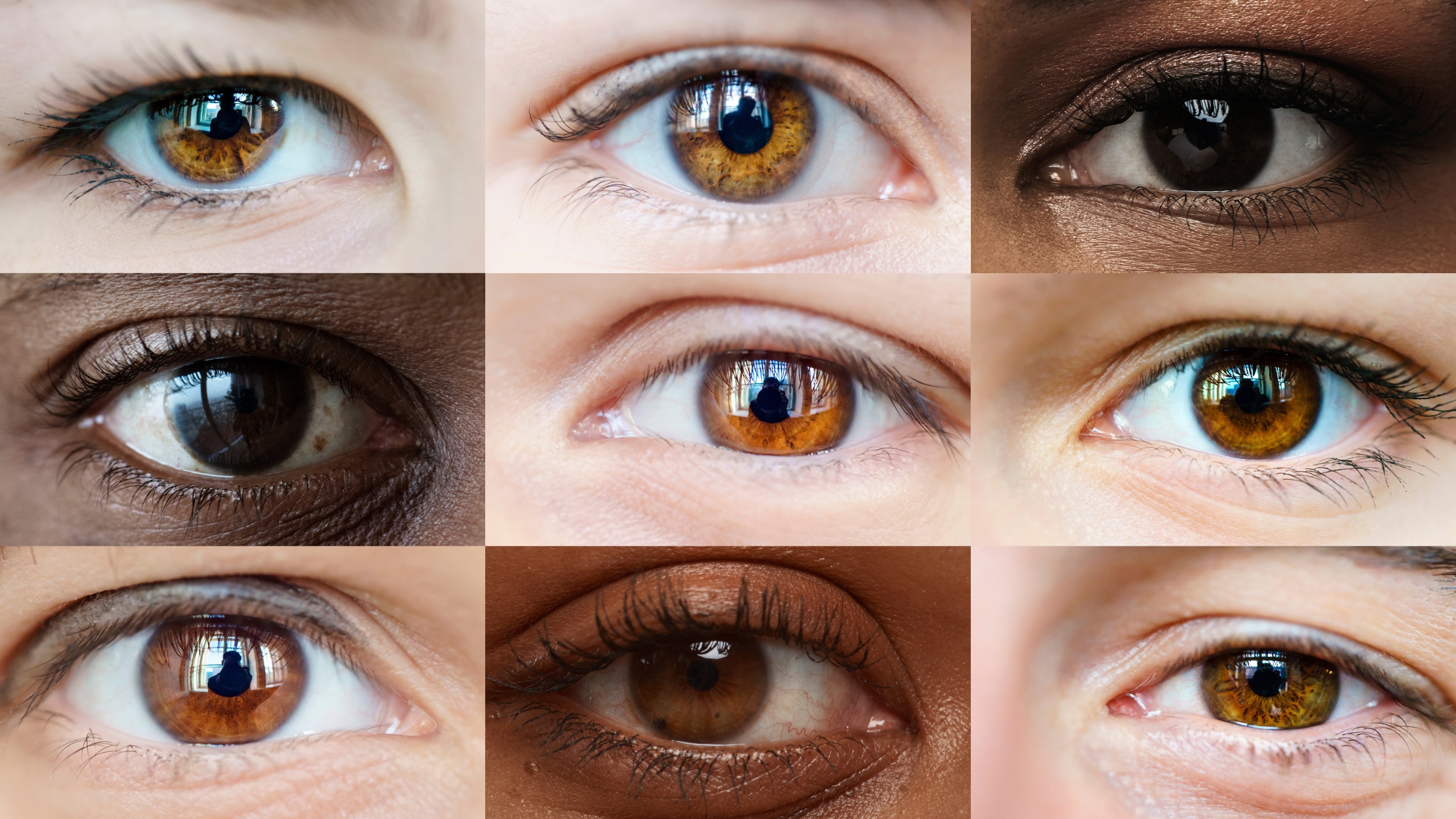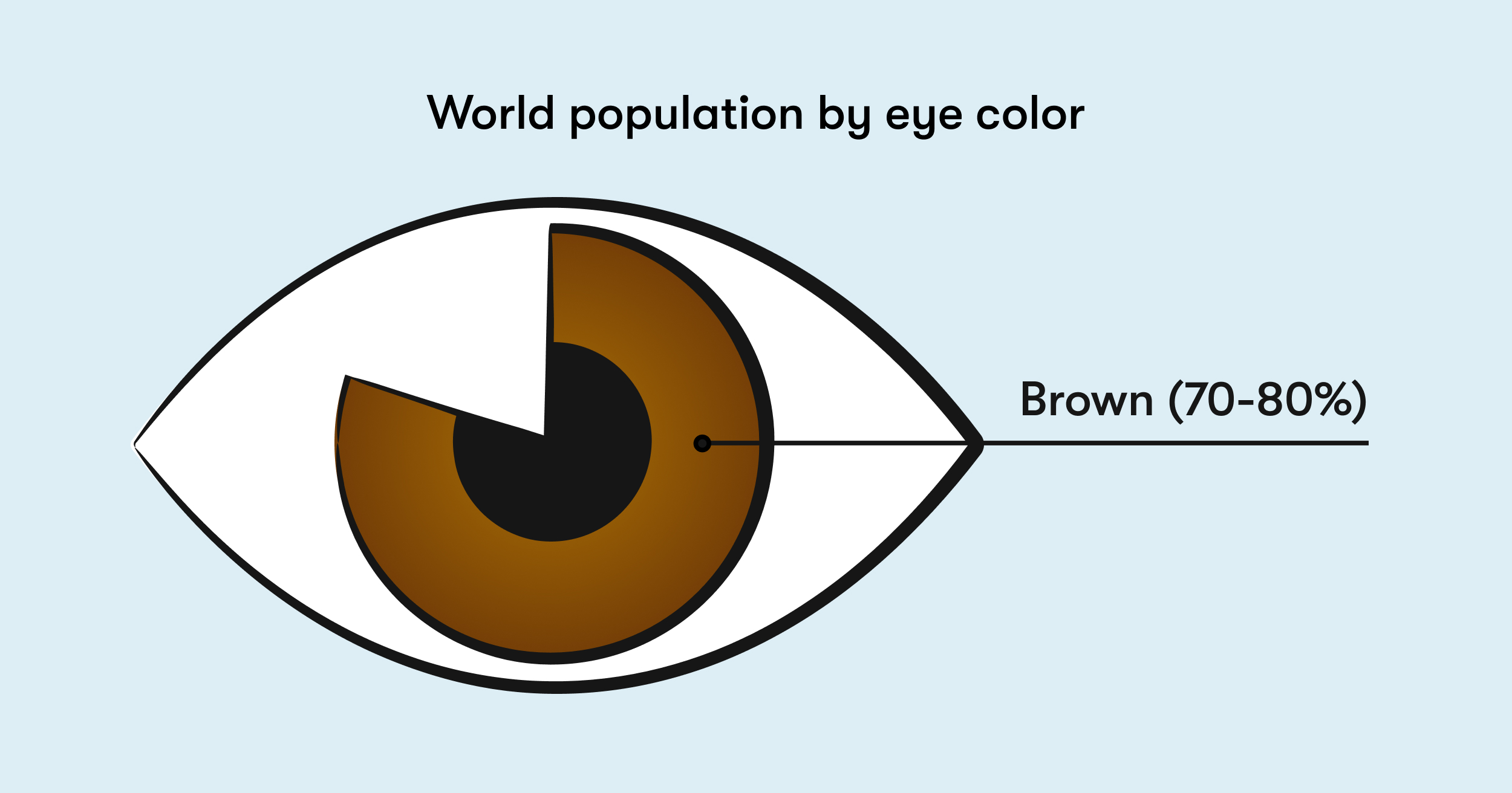Brown eye color
Brown eyes are the popular kid of the eye-color world, showing up in numerous shades across most of humanity. In fact, human history started out brown-eyed. Over time, genetic mutations gave rise to blues and greens, but brown eyes held onto their starring role.
You can always switch up your look with colored contact lenses if you want to see life from a new hue. Before you do, let’s explore why brown eye color is so fascinating, what causes it, and how to make it shine even brighter.
What are the different shades of brown eyes?
There’s no one-size-fits-all brown. From toasty light brown eyes to dark brown eyes that look almost black, each shade brings its own personality. Here’s a closer look:
-
Light brown eyes: These caramel-like beauties often have a golden or slightly hazel cast. In bright sunlight, they might reveal flecks of green or amber.
-
Dark brown eyes: Imagine rich espresso — deep and warm, with plenty of melanin. Under certain lighting, you see hints of chocolate or coffee tones.
-
Honey brown eyes: This shade gleams with an amber glow. Think of actual honey: warm, luminous, and a touch lighter than classic brown.
-
Chestnut brown eyes: A medium-intensity brown that can shift from softly golden to a deeper russet. Chestnut eyes usually look vibrant in daylight.
-
Amber brown eyes: Amber brown tends to lean into an orange-brown territory, sometimes mistaken for hazel because of its bright, fiery hue.
-
Café au lait brown eyes: Light and milky-brown, this color resembles a gentle mocha. These can show subtle variations of gray or green undertones.
Every set of brown eyes is unique, blending tiny differences in melanin distribution. So, if someone says, “Oh, but all brown eyes look the same,” feel free to politely disagree. Brown eyes run the gamut from barely-there beige to “hello darkness, my old friend” levels of deep.

Causes and the genetics of brown eyes
Why exactly do most people on the planet end up with a brown gaze? It boils down to melanin, a natural pigment found in your skin, hair, and eyes. Melanin is produced by cells called melanocytes, which live in your iris (the colored part of your eye). The more melanin these cells produce, the darker your eye color becomes. That’s why light brown eyes have a lower melanin level, while dark brown eyes are swimming in it.
Beyond simple pigment, genetics determine how much melanin your iris produces. Genes like OCA2 and HERC2 are key players here, helping regulate melanin production in the eyes. Even if you gaze deeply into non-brown eyes, there’s still some melanin—just a bunch less. So, you could say all eye colors secretly contain a bit of brown.
Are brown eyes dominant? In broad strokes, yes, brown-eye genes often overshadow blue or green ones. That’s why two parents with brown eyes frequently have brown-eyed kiddos. Still, real-life genetics can get wacky. (Spoiler alert: We’ll get to “Can two brown eyes make blue?” in a moment.)
Are brown eyes rare?
Brown eyes hold the crown as the world’s most popular eye color. In some parts of the globe, nearly everyone you meet has brown eyes — we're talking entire families, neighborhoods, and, yes, entire regions.
In the United States, estimates suggest that just under half of all Americans have brown eyes. So, think of brown-eyed people as the ultimate party hosts. They’re everywhere, bringing the warm, approachable vibes.
What percentage of people have brown eyes?
A whole lot. Around 70–80% of the global population has brown eyes, making them the most common eye color on the planet. That’s billions of people with gazes ranging from light honey to deep espresso. So, if you’ve ever felt like you’re surrounded by brown eyes… you are. And for good reason, brown eyes are powered by high levels of melanin and some strong genetics. Basically, nature keeps hitting "repeat" on this one.

Can two blue eyes make brown?
Short answer: It’s unlikely for two blue eyes to make brown, but in rare genetic curveballs, they can. Typically, two blue-eyed parents lack the “brown-eye gene.” However, genetics can be more complex than a single gene pair, and hidden variations sometimes exist.
For example, if both parents carry recessive brown genes somewhere in the family tree, a child could potentially end up with light brown or hazel eyes. It’s the exception, not the norm — but stranger things (like two different color eyes — thinking of you, Kate Bosworth) have happened.
Can two brown eyes make blue?
Yes, absolutely. Brown-eyed parents can carry recessive genes for lighter colors. If both pass along that recessive gene, the child could be born with blue eyes. It’s not the most common scenario, but it’s definitely possible. Some families have multiple kids with various eye colors, thanks to the genetic shuffle. So, even though brown eyes are dominant, they’re no match for genetics’ love of surprises.
Do brown eyes have health benefits?
Brown eyes also bring interesting health perks. Researchers have noted a higher melanin count can offer extra protection from bright light as well as certain eye conditions. Sunglasses remain every eye’s best friend. Still, knowing your brown eyes might carry built-in defenses is a nice bonus.
Complimentary colors and tips for making brown eyes pop
Brown eyes are a neutral canvas, which means they pair beautifully with a wide array of colors. Whether you have soft, light brown eyes or intense dark brown eyes, you can play with fashion and makeup to amplify their glow.
What color makes dark brown eyes pop the most?
For dark brown eyes, think contrasts. Jewel tones like emerald green or sapphire blue create an exciting clash with the warm brown, drawing attention straight to your gaze. Purples — especially royal purple or plum — can also bring out hidden golden undertones.
Warm metallic accents (gold, bronze, copper) complement dark brown eyes perfectly if you want a more harmonious vibe rather than a bold contrast. Your face shape and hair color might shift your choices slightly — someone with cool-toned hair might lean into purple or blue more, for instance.
Ultimately, experimentation is key. Try on a few jewel-toned outfits or metallic eyeshadows and see which combination makes your reflection light up.
Eyeshadow colors for brown eyes
If you’re aiming to enhance your brown eyes through makeup, you have plenty of options. Below are quick guidelines depending on your uniquely gorgeous shade:
-
Dark brown eyes: Deep plums, navy blues, emerald greens, or midnight grays add strong contrast. Metallics like bronze or rose gold reflect light and highlight any subtle flecks of amber in your iris.
-
Honey brown eyes: Purple is your secret weapon. Try lilac, amethyst, eggplant, or soft violet to complement the golden undertones. Peach or copper shadows can also intensify that radiant glow.
-
Light brown eyes: Champagne, caramel, peach, or a hint of teal can amplify your naturally warm hue. If you want extra contrast, try a soft turquoise or lavender along the lash line.
-
Chestnut brown eyes: Rose gold, warm burgundy, soft coral, or earthy browns can emphasize the gentle reddish undertone in chestnut irises. Adding a bit of shimmer on the lid center can give added dimension.
-
Amber brown eyes: Lean into bronzy oranges, rusty reds, or warm golds to mirror the vibrant, fiery cast of amber.
-
Café au lait brown eyes: Soft browns, muted pinks, plummy taupes, or subtle metallics match the milky-brown tone. A gentle wash of champagne can brighten the eyes for an everyday look.
In all cases, don’t be shy about mixing finishes. Shimmer or metallic accents on the lid center can catch the light for extra dimension.
Which lens color is best for dark brown eyes?
The best lens color for dark brown eyes depends on how dramatic you want the transformation to be.
-
If you only want a subtle boost, pick an enhancement tint close to your existing shade, like a honey brown or hazel, that gently lightens or warms up your dark brown eyes.
-
If you’re feeling bold, go for a strong contrast with blue or green contacts. You’ll see a total color shift, assuming you choose opaque-colored lenses designed for dark irises.
Brands like Air Optix Colors offer various hues that effectively overlay dark eyes. Whether you want a natural shift or a head-turning glow-up, you can find an option that suits your style. It’s really about preference and how much of a statement you want to make.
Do Air Optix colors work on brown eyes?
Air Optix Colors are specifically engineered to show up on brown eyes, including very dark ones. They use a pigment layer that masks your natural color, so if you pick “Brilliant Blue,” you’ll likely see a noticeable blue result rather than a muddy overlap. If you already have brown eyes and want to enhance them, you can choose a shade like Hazel or Honey for a subtle effect.
If you don’t have brown eyes but want them, Air Optix Colors also has brown-toned lenses for that exact purpose. Whatever your goal, just remember you need a valid prescription from an eye care professional, even for purely cosmetic contacts.
Can dark brown eyes wear blue contacts?
Absolutely, many wearers with dark brown eyes love the contrast of a bright or cool-toned blue lens. The key is picking opaque contact lenses that can fully cover darker pigments.
Natural lighting also plays a role, with sunlight bringing out the vibrancy of colored lenses more than indoor lighting. If you’re curious which brand might suit you best, consider ordering a couple of lens samples (with your eye care professional’s guidance, of course). You might be surprised how easily you can rock a whole new hue.
Are brown eyes attractive?
Beauty is personal, but brown eyes are definitely striking. Some people associate brown eyes with cuteness, warmth, reliability, or a dash of mystery — like there’s something inviting about that cozy hue. Others find them universally appealing because brown eyes tend to look good with almost any hair color or skin tone. Plenty of cultural references (Grateful Dead and Van Morrisson, we see you) celebrate the allure of brown eyes.
Ultimately, whether brown eyes are attractive depends on individual taste, but there’s no shortage of admirers. If you want to switch things up temporarily, color contacts let you experience something new — maybe a dazzling green or a dreamy blue. That said, many people discover once they’ve tried another shade, they come right back to loving their signature brown.
Brown eyes (and every other shade) deserve great care — and maybe a new color experiment now and then.
Did you know you can order contacts online?
Say goodbye to trips to the eye doctor and hello to convenience! With 1-800 Contacts, you can easily order your contact lenses online and have them delivered straight to your door. Plus, our online vision exam makes it simple to get the prescription you need without leaving home. And the best part? You’ll save money on your first order with 1-800 Contacts. It’s never been easier to get your contacts!





